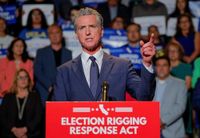As the 2026 midterm congressional elections loom, a fierce political battle over redistricting is erupting between the nation’s two most populous states: California and Texas. In a dramatic break from the traditional post-census redrawing of congressional maps, leaders in both states are racing to reshape their districts, each hoping to tilt the balance of power in their party’s favor. The stakes? Nothing less than the control of the U.S. House of Representatives, where Republicans currently hold a razor-thin 219-to-212 majority, according to NPR.
This unusual mid-decade redistricting push was set in motion by former President Donald Trump, who recently called on Texas officials to create five new congressional districts favoring Republican candidates. Texas Republicans, eager to answer that call, are working to redraw their state’s maps to carve out the additional GOP-leaning seats. Democrats in the Texas legislature, however, staged a dramatic walkout, denying the chamber a quorum and temporarily blocking the vote. In response, Texas House Speaker Dustin Burrows issued arrest warrants for the absent lawmakers, while Governor Greg Abbott sought court orders to remove and replace them.
Meanwhile, California’s Democratic leadership is mounting a counteroffensive. Governor Gavin Newsom announced on August 14, 2025, that he would push for a special election on November 4, putting new congressional maps before voters in an effort to offset Texas’s anticipated gains. At a news conference in downtown Los Angeles, Newsom declared, “I know they say 'Don't mess with Texas.' Well, don't mess with the great Golden State.” He added, “We're doing this in reaction to a president of the United States that called a sitting governor of the state of Texas and said, 'Find me five seats.'”
Newsom’s plan, which requires approval from two-thirds of the state legislature to appear on the ballot, would allow for midterm redistricting in 2026, 2028, and 2030. He framed the move as a necessary, though temporary, response to what he described as a "five-alarm fire for democracy in the United States of America." In a campaign video released alongside his announcement, Newsom accused Trump of trying "to rig the election." The governor also assured voters that California’s independent Citizens Redistricting Commission would resume its usual work after the 2030 census.
Redistricting, the process of redrawing congressional districts to reflect population shifts, is typically carried out every ten years following the census. The U.S. House has 435 seats, with each district representing roughly 700,000 people. While the census determines how many seats each state gets, the responsibility for drawing the actual district lines falls to the states themselves. Laws governing the process vary widely: some states, like California, use independent commissions to reduce political influence, while others, such as Texas, leave the task in the hands of partisan legislatures.
The technicalities of redistricting may seem dry, but the stakes are enormous. The way districts are drawn can determine not only which party wins but whether voters feel their ballots truly count. Gerrymandering—the manipulation of district lines to favor a particular party or group—has a long, controversial history in American politics. The term itself dates back to the early 1800s, when Massachusetts Governor Elbridge Gerry approved a district shaped like a salamander, giving rise to the portmanteau "Gerry-mander."
Modern gerrymandering relies on tactics like "packing" (concentrating opposition voters in a few districts to limit their influence elsewhere) and "cracking" (spreading them thinly across many districts to dilute their power). The Brennan Center for Justice, a nonpartisan organization, warns that such practices "skew election results, make races less competitive, hurt communities of color, and thwart the will of the voters." Racial gerrymandering—drawing lines to weaken the voting power of a racial group—is illegal, but partisan gerrymandering remains largely unchecked following a 2019 Supreme Court ruling.
Texas Republicans insist their proposed maps are about partisan, not racial, advantage. They point to the creation of Latino-majority districts as evidence that they are expanding opportunities for minority voters. But critics, including Democratic U.S. Representative Jasmine Crockett, argue that the new districts go too far: "There is some district that went up to 70-something percent Latino. That is packing. You don't need some district to be almost 80% Latino for that district to perform as a Latino-opportunity seat." Texas state law does not prohibit partisan gerrymandering, and Republican lawmakers have cited the Supreme Court’s decision to justify their approach. "The courts have consistently held that redistricting for purposes of political performance by either party is acceptable," said Republican state Representative Tom Oliverson, as reported by NPR. "Other states have done that."
California’s approach, at least until now, has been different. The state’s Citizens Redistricting Commission was established more than a decade ago to take politics out of the process. Newsom’s current maneuver, however, seeks to temporarily bypass the commission in order to respond to Texas and other Republican-led states considering similar mid-decade redistricting efforts. Newsom emphasized that if Texas and other states like Missouri, Florida, and Indiana abandon their plans, California would halt its own. "This does not go forward...unless one of these other states move forward," he told reporters. "We're hopeful they don't move forward. If that's the case, this effort will not be necessary. But we're not waiting."
The move has drawn sharp criticism from Republicans. U.S. Representative Kevin Kiley of California, who has introduced a bill to ban mid-decade redistricting, wrote on social media, "We will not let Gavin Newsom destroy democracy in California." State Assembly Republican Leader James Gallagher accused Newsom of "drawing maps in the dark with political consultants and likely politicians' input and influence and then giving 5 days notice for public input on maps that have already been decided." National Republican Congressional Committee spokesperson Christian Martinez called the move "nothing more than political posturing for his 2028 pipe dream," and accused Newsom of "shredding California's Constitution and trampling over democracy."
Even as Newsom made his announcement at the Democracy Center in Los Angeles, the event was overshadowed by federal immigration enforcement activity outside the venue. Newsom and Los Angeles Mayor Karen Bass both described the timing as provocative, with Bass stating, "This was widely publicized that the governor and many of our elected officials were having a press conference here to talk about redistricting. And they decided they were going to come and thumb their nose in front of the governor's face." U.S. Customs and Border Protection officials denied any connection, insisting the arrests were part of routine "roving patrols."
As California’s legislature prepares to debate the special election and Texas lawmakers press ahead with their own plans, the nation is left to watch as the rules of political engagement are rewritten in real time. Whether these maneuvers will ultimately empower voters or further entrench partisan divides remains to be seen, but the outcome will undoubtedly shape the direction of American democracy for years to come.





